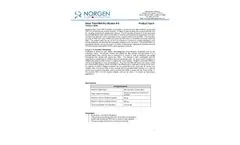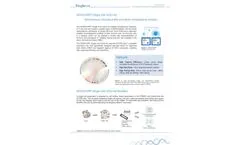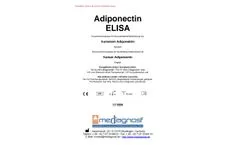gene-expression Downloads
24 downloads found
Chromium Single Cell Gene Expression provides single cell transcriptome 3' gene expression and multiomic capabilities to profile tens of thousands of cells. Explore cellular heterogeneity, novel targets, and biomarkers with combined gene expression, surface protein expression, or CRISPR edits in each ...
The purified RNA is of the highest integrity, and can be used in a number of downstream applications including real time PCR and reverse transcription PCR for gene expression ...
A 5 ½ day hands-on laboratory course in which participants will learn skills to effectively design separation and purification strategies for downstream processing. This course uses the remarkable Green-Fluorescent Protein (GFP), a novel marker for gene expression, as the source material. While this is a general course applicable to all proteins, we use GFP as a highly effective visual ...
CD Genomics provides a complete list of transcriptomics sequencing to meet the needs and budget of our clients. Transcriptomic sequencing can be used for differential expression analysis, detection of mutations (SNPs/InDels), and functional annotation. This is a brief overview of our transcriptomic services. Visit https://www.cd-genomics.com/Transcriptomics.html for more facts. ...
GEXSCOPE Single Cell V(D)J Kit enables simultaneous detection of T-cell or B-cell receptor gene expression, together with whole transcriptome expression at single-cell level. ...
Adeno-associated viruses (AAVs) are derived from defective parvoviruses, which depend on essential helper functions provided by other viruses, such as adenovirus and herpes virus, for efficient viral replication and propagation. AAV has no etiologic association with any known diseases and has been successfully used to establish efficient and long-term gene expression in vivo in a variety of ...
MicroRNAs (miRNAs) are a class of non-coding RNAs of approximately 20-24 nucleotides in length. By base-pairing to the targeted mRNA, miRNA promotes mRNA degradation or represses its translation and participates in the post-transcriptional regulation, thereby inhibiting targeted gene expression. ...
Gene Panel has been an invaluable tool to analyze parallel gene expression for disease-associated mutations. Next-generation sequencing (NGS) technologies are perhaps the most widely used approaches for gene panel, which can analyze genetic mutations of large sample-size projects and facilitate research on human well-being. https://www.cd-genomics.com/diseasepanel/non-ngs-panel.html ...
Most rare and inherited diseases have a neurological component, likely because more than 80% of human genes are expressed in the brain.1 Neurological disorders are multifactorial and heterogeneous, meaning that their genetic basis is often poorly understood. Indeed, only 30-50% of neurological disorders have a molecular genetic diagnosis.2 ...
Human recombinant ASH1L bromodomain. ASH1L is a large (333 kDa), multi-domain protein associated with actively transcribed regions of chromatin. Its bromodomain lies C-terminal to its SET domain, which confers histone H3K36 methyltransferase activity. ASH1L is the human homolog of Drosophila Ash1, a Trithorax group protein. Like its counterpart in Drosophila, ASH1L has been found to play a role ...
To support medical research and translation, CD Genomics provides a full range of sequencing/microarray-based approaches including gene expression profiling, RNA-seq, whole-genome sequencing (WGS), whole-exome sequencing (WES), epigenomics, and single-cell sequencing for detecting tumour heterogeneity. ...
Whole-Genome Sequencing can be used to determine which antibiotic resistance genes (ARGs) are present in microbial strains, discover novel ARGs, identify mobile genetic elements that promote the transfer of ARGs to other microorganisms and assess the safety of particular bacterial strains. https://www.cd-genomics.com/microbioseq/gene-expression-analysis.html ...
To support medical research and translation, we provide a full range of sequencing/microarray-based approaches including gene expression profiling, RNA-seq, whole-genome sequencing (WGS), whole-exome sequencing (WES), epigenomics, and single-cell sequencing for detecting tumor heterogeneity. ...
To support medical research and translation, CD Genomics provides a full range of sequencing/microarray-based approaches including gene expression profiling, RNA-seq, whole-genome sequencing (WGS), whole-exome sequencing (WES), epigenomics, and single-cell sequencing for detecting tumour heterogeneity. https://www.cd-genomics.com/Gene-Expression-Profiling-Microarray-Service.html ...
Gene Panel has been an invaluable tool to analyze parallel gene expression for disease-associated mutations. Here we present four powerful non-NGS technologies for gene panel that can promote your disease research, biomarker discovery, and targeted drug development. https://www.cd-genomics.com/diseasepanel/non-ngs-panel.html ...
Gut microbes provide energy to microbiota by digesting food residues and releasing metabolites for the gut, affecting the host if they enter the host's circulatory system. Conversely, intestinal metabolites can influence the composition, gene expression, and gut microbiota-derived metabolites. ...
Adiponectin is a protein of 30kDa which exists in several multimeric forms. About 0,01% of the proteins in human serum are adiponectin. The ADIPOQ-Gen is the gene mostly expressed by adipocytes. In spite of that the serum adiponectin concentration is negatively correlated with body fat mass. The protein consists of 244 amino acids and has a globulary domain which shows similarity to TNF alpha. ...
Genomic technologies have now been extensively applied to the biomarker development process. It is a versatile tool to identify genomic variants, differentially expressed genes, and differential methylation patterns, as well as investigate pathway and gene regulation networks. ...
CUT&Tag sequencing can be used to examine gene regulation or analyze transcription factors and other chromatin-associated protein bindings. Protein-DNA interactions regulate gene expression and are responsible for many biological processes and disease states. This epigenetic information is complementary to genotype and expression analysis. ...
Gut microbes provide energy to microbiota by digesting food residues and releasing metabolites for the gut, affecting the host if they enter the host's circulatory system. Conversely, intestinal metabolites can influence the composition, gene expression, and gut microbiota-derived metabolites. https://metabolomics.creative-proteomics.com/microbial-metabolomics-service.htm ...










![Reaction Biology - Model ASH1L- [BRD] - Bromodomain Proteins - Brochure Reaction Biology - Model ASH1L- [BRD] - Bromodomain Proteins - Brochure](/_ipx/f_webp&q_80&s_240x145/https://d32zuqhgcrpxli.cloudfront.net/eyJidWNrZXQiOiJlZS1maWxlcyIsImtleSI6ImZpbGVzLzExNTUzNy9kb3dubG9hZC8xMDIxNzE5LzExNTUzN18xOV8yMDIxMDQxNjA4MTQzNjM4MjAxMzFfdGh1bWJuYWlsX2JpZy5qcGciLCJlZGl0cyI6eyJyZXNpemUiOnsiZml0IjoiY29udGFpbiIsImJhY2tncm91bmQiOnsiciI6MjU1LCJnIjoyNTUsImIiOjI1NSwiYWxwaGEiOjF9LCJ3aWR0aCI6MjQwLCJoZWlnaHQiOjE0NX19fQ==)






